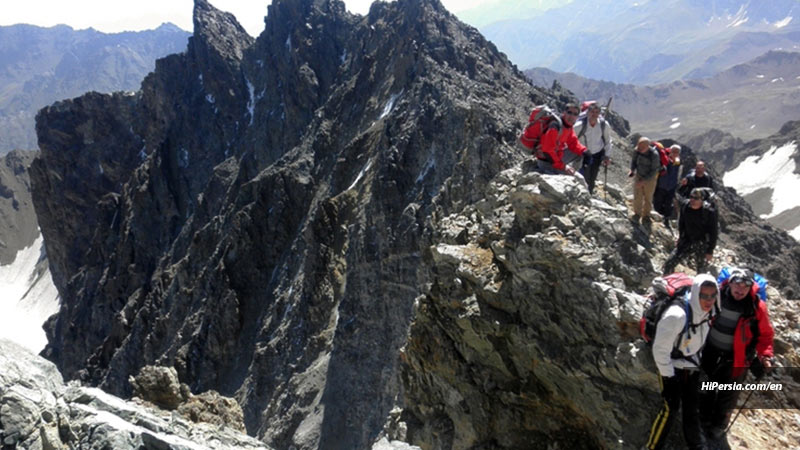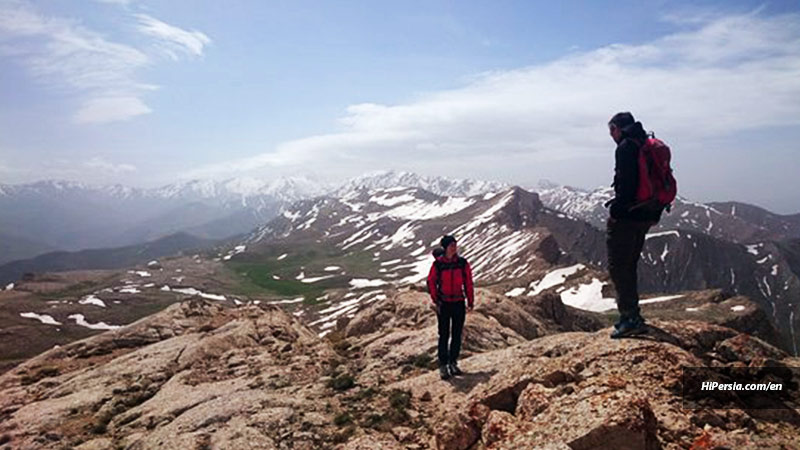



Mount Alam is a mountain in the Alborz mountain range in the north of Iran forming a peak of the Takht-e Suleyman Massif. It is the second highest peak in Iran with an elevation of 4,848 meters behind Mount Damavand.
Mount Alam (Alam Kooh) is sometimes been written as: "Alamkouh", "Alamkoh", "Alamkuh", "Alamkooh" or "Alam kouh". Mount Alam (Alam Kooh) is mainly made of tertiary intrusive rocks; granite and diorite. Some Triassic and Jurassic sediments are also found. The first recorded ascent of the peak was made from Hazarchal over the south face of the German brothers Bornmüller during their six-month botanical exploration of the Alborz in 1902. The gigantic rocky block in the heart of Takht-e-Soleiman massif makes a one km long raged east-west running Ridgeline that is entirely above 4700m, the western one quarter of the Ridgeline makes the Alam Kooh section including the 4850m Alam Kooh peak, and the eastern part makes five horns shaped peaks known as Shakhak-1, Shakhak-2, Shakhak-3, Shakhak-4 and Shakhak-5, the north face of this block creates vertical walls of Alam Kooh and Shakhak. There is a perfect 350m wall under the summit of Shakhak-5 sometimes it can be seen even more impressive than an Alam Kooh wall in some photos which have the height range between 350m and 600m (including steep glacier). Alam Kooh famous for its wall. But fame is not for being the tallest wall of Iran and it isn't, but the fame is for being the wall having the highest altitude at base and peak I mean no other wall in Iran is located in a higher place than an Alam Kooh wall. There is a glacier name Alamchal at the base of the north face that slightly rises to about 4200m. Then there is about 150m to 200m, very steep glacier (nearly vertical). And the wall rises about 450m vertical granite rock up to the summit.

Climbing Mount Alam (Alam Kooh) via all north routes is class five high altitude technical climbs which need to hard struggle with rock, ice and rock falls, but the southern slopes of Alam Kooh and the Shakhaks are steep covered with boulders and/or scree and they form Khersan and Marjikesh glaciers. The southern routes are easy class three climbs in summer. Anyway, climbing Alam Kooh by any route in winter is difficult and technical.

The whole Alborz mountain area and its wild nature are a protected place as mount Alam, so hunting, fishing, and harming nature is prohibited. No fees of permission are required for climbing or camping and No problem for camping, but watch out for the danger of avalanches and rockfalls. For Numerous rockfalls and avalanches, frostbite, getting lost, wild animals, important to get enough prepared and informed about the region by the locals. You can get information about this adventure climbing at the Iran Federation of Mountaineering (IFM) Hotel located at Roodbarak. But we advise you to hire a local guide to come with you. Anyway, If you going alone report your entrance to the region and the time you want to spend on the massif to the Roudbarak Iran Federation of Mountaineering Hotel (IFM) or the locals before performing a climb and get enough details from them too, they would send rescue if you are late.
Mount Alam is a mountain in the Alborz mountain range in the north of Iran, Mazandaran Province located exactly in the Kelardasht District of the Mazandaran Province of Iran, forming a peak of the Takht-e Suleyman Massif. From Tehran, you have to go to Karaj Chalous road. 24Km before Chalus at Marzanabad village turn left toward Kelardasht (you can take the public bus to here by 300.000 Rial.) Then you have to go to the Roudbarak village by Nisan or you have to ask IFM for a landrover (around 3.000.000 Rial), it is located near Hasankif village, at the end of Roudbarak there is a dirt road, after about 8Km (40minutes by car) it reaches Vandarbon cars jut take you here. now choose to climb the south face or north face.






“Oh! Squander not this breath that Heaven hath lent thee, Nor make too sure another breath to borrow!’” Khayam